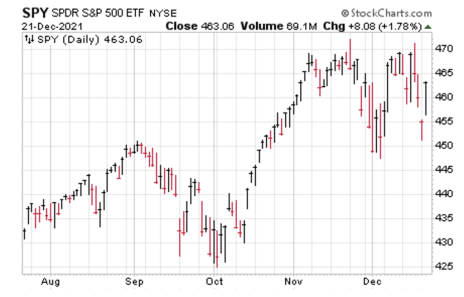Selling Premium in the S&P 500 (SPY)
We’ve had some good fortune since late August using bear call spreads on the major market ETFs. The heightened volatility has allowed us to take on some fairly conservative trades that have thankfully led to some decent profits. And even though I tend to go out 30-60 days with these trades, my average hold time has been just over two weeks.
Credit spreads are great strategies for this market environment, particularly for those who prefer risk-defined options strategies. Over the past month I’ve posted three trades using simple credit spreads, bear call spreads to be exact, that have fortunately led to some decent profits.
As I’ve discussed on a few occasions, with a bear call spread I have a decent margin of error just in case the stock, or ETF in today’s example, pushes higher. If it pushes lower, particularly if it is immediate, I should be able to lock in a quick gain.
[text_ad use_post='261460']
A few months ago we placed a bear call spread in the SPDR S&P 500 ETF (SPY). Several weeks afterwards we spoke about the potential of locking in 12.4%. Now the spread trades for roughly $0.12 for a profit of 14.9%.
Shortly after that trade we mentioned another bear call spread in IWM. One week later the spread trades for $0.30 for a quick profit of 9.9%. The max potential profit on the high-probability trade is 17.6%.
And following that trade, we placed another trade in the SPDR S&P 500 ETF (SPY). We were able to lock in roughly $0.12, a 17.4% profit.
And most recently, we placed another trade in the SPDR S&P 500 ETF (SPY). Now the spread trades for roughly $0.30, a 10.0% profit. Just a few days prior we could have taken the trade off the table for 15.3%.
Today, I’m going to continue to sell bear calls spreads with another potential hedge/bearish-leaning trade in SPY.
The Trade
With SPY trading for 463.06 I want to place a short-term bear call spread going out 31 days. My intent is to take off the trade well before the January 21, 2022 expiration date. For this bearish spread example, my preference is to go with a trade that has around an 80% to 85% probability of success.
The Trade – Bear Call Spread Example
Let’s start by taking a look at the options chain for SPY with 31 days until expiration. Once we choose our expiration cycle (it will differ in duration depending on outlook and strategy), we begin the process of looking for a call strike within the January 21, 2022 expiration cycle that has around an 80% probability of success.
If you don’t have access to probabilities of success on your trading platform look towards the delta. Without going into too much detail, look for a call strike that has a delta around 0.20, as seen below.
Since we are focused on using a bear call spread, we only care about the upside risk at the moment.
The 481 call strike, with an 84.72% probability of success, works. It’s just inside the expected range, but we can adjust accordingly if needed. I want to have an opportunity to bring in 16.3%, while keeping my probability of success around 85%.
The short 481 call strike defines my probability of success on the trade. It also helps to define my overall premium, or return, on the trade. Basically, as long as SPY stays below the 481 call strike at the January 21 expiration in 31 days we will make a max profit on the trade. But, as I stated before, my preference is to take off profits early and, in most cases, reestablish a position if warranted.
Also, time decay works in our favor on the trade, so as we get closer and closer to expiration our premium will erode at an accelerated rate. As a result, we should have the opportunity to take the bear call spread off for a nice profit prior to expiration–unless, of course, SPY spikes to the upside over the next 31 days. But still, that doesn’t hide the fact that with this trade, we can be completely wrong in our directional assumption and still make a max profit.
Once I’ve chosen my short call strike, in this case the 481 call, I then proceed to look at the other half of a 3-strike wide, 4-strike wide and 5-strike wide spread to buy.
The spread width of our bear call defines our risk/capital on the trade.
The smaller the width of our bear call spread the less capital required, and vice versa for a wider bear call spread.
When defining your position size, knowing the overall defined risk per trade is essential. Basically, my premium increase as my chosen spread width increases.
Bear Call Spread: January 21, 2022 481/486 Bear Call Spread or Short Vertical Call Spread
Now that we have chosen our spread, we can execute the trade.
Simultaneously:
Sell to open SPY January 21, 2022 481 strike call.
Buy to open SPY January 21, 2022 486 strike call for a total net credit of roughly $0.70 or $70 per bear call spread.
- Probability of Success: 84.72%
- Total net credit: $0.70, or $70 per bear call spread
- Total risk per spread: $4.30, or $430 per bear call spread
- Max Potential Return: 16.3%
Again, as long as SPY stays below our 481 strike at expiration in 31 days, I have the potential to make a max profit of 16.3% on the trade. In most cases, I will make less, as the prudent move is to buy back the bear call spread prior to expiration. Again, I look to buy back a spread when I can lock in 50% to 75% of the original credit. Since we sold the spread for $0.70, I would look to buy it back when the price of my spread hits roughly $0.35 to roughly $0.15.
Of course, there are a variety of factors to consider with each trade. And we allow the probabilities and time to expiration lead the way for our decisions. But, taking off risk, or at least half the risk, by locking in profits is never a bad decision and by doing so we can take advantage of other opportunities the market has to offer.
Risk Management
Since we know how much we stand to make and lose prior to order entry we can precisely define our position size on every trade we place. Position size is the most important factor when managing risk, so keeping each trade at a reasonable level (I use 1% to 5% per trade) allows not only the Law of Large Numbers to work in your favor … it also allows you to sleep well at night.
I also tend to set a stop-loss that sits 1 to 2 times my original credit. Since I’m selling the 481/486 bear call spread for $0.70, if my bear call spread reaches approximately $1.40, I will exit the trade.
As always, if you have any questions, please do not hesitate to email me or post a question in the comments section below. And don’t forget to sign up for my Free Newsletter for education, research and trade ideas.


